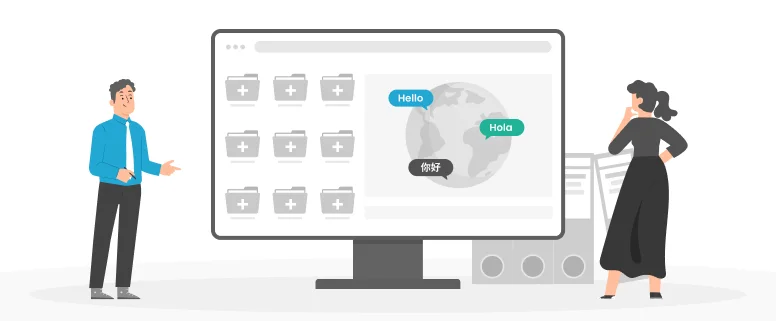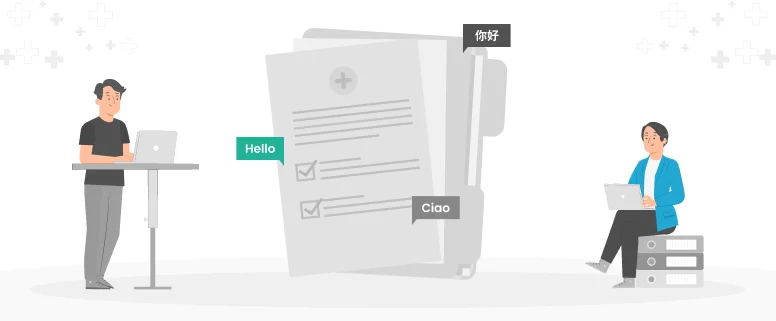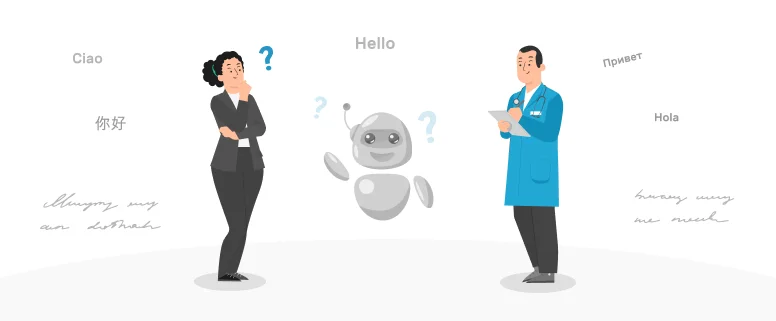Medical documentation is the record doctors maintain containing information about the patient’s healthcare. Observing these documents helps both medical professionals and individuals perform the right medication procedure and follow the instructions carefully. Medical documents are broadly categorized into two types: clinical and non-clinical.
Clinical documents are records maintained by healthcare providers. They directly relate to a patient’s medical care. These documents contain essential information like diagnoses, treatment plans, allergies, medications, and progress notes.
Non-clinical documents, while still important, don’t directly involve a patient’s medical treatment. They typically include details like insurance information, appointment schedules, billing records, and patient demographics. These are a type of administrative records that contain the details necessary for managing patient care. Keep reading to find out:
Table of Content
How Does Medical Documentation Enhance Patient Care?

Verbal descriptions are never enough for doctors. They always demand proper documents. Some common medical documents examples are test reports, previous prescriptions, and diagnoses to examine their patients. Detailed records help doctors understand a patient’s health fully and make informed decisions about their care. When all the important medical information is recorded, doctors in different places and who speak different languages can easily see the whole picture of a patient’s health. This makes it much smoother when a patient needs to move their care from one place to another.
Moreover, there are other functions of these documents. Healthcare seekers usually hesitate to communicate with clinicians. Just in case, physicians highly rely on documents to effectively correspond with patients no matter what language they speak. In order to provide the best care possible, doctors cannot be hindered by language barriers.
10 Vital Medical Documents That Need to be Translated

Medical documents are a crucial component of patient care. As a medical translation company, we have helped numerous healthcare providers effectively communicate and understand medical details by translating documents into multiple languages. Based on our vast experience, we have put together a list for you of the most widely used medical documents that need translation.
• Patient Medical Records (PMR)
You might have observed that the first thing every doctor does while seeing a patient is taking notes. Do you know how important these notes are? They are actually the PMR documents that contain a patient’s medical history, diagnoses, and treatment details. The document is maintained to ensure that the relevant information is safely transported across healthcare providers. Medical records translation helps patients get the right treatment and care from non-native doctors and completely understand their health status and treatment plan.
• Consent Forms
The most difficult thing is to sign a medical consent form, right? What makes it more scary is the language barrier. The signee will not be able to fully comprehend the dangers, advantages, and specifics of the medical procedure if the permission form is in a foreign language. Thus informed consent form translation services hold great importance. When consent forms are translated accurately, multilingual people are guaranteed to comprehend and be completely informed of their rights and options.
• Medical Billing and Insurance Documents
The insurance procedure itself is a headache, and claiming insurance in a foreign country often requires translating the bills and applications into the local language. A clear translation of these documents clarifies the patient’s financial responsibilities, insurance coverage, and any necessary steps to resolve claims or disputes. Moreover, medical document translation helps reduce confusion and ensure effective communication with providers.
• Laboratory and Diagnostic Reports
Test reports and scans provide doctors with information that they do not get with the naked eye. These documents provide critical information on a patient’s health. Translating medical reports (laboratory and diagnostic) helps patients comprehend their medical conditions and follow-up requirements and ensures that the right treatment is given.
• Prescription and Medication Records
We take it that a patient has to take their medication as prescribed by their doctor? Information on prescribed medications, dosage guidelines, administration techniques, and any adverse effects are all included in prescription and prescription records. These records are essential for making sure patients take their medications as directed and steer clear of harmful interactions. Prescription record translation reduces the possibility of misuse or non-compliance by ensuring that patients who speak different languages comprehend their medication schedules.
• Progress Notes
Remember, your healthcare provider always asks you to maintain your medical file containing all your current and previous reports. That’s because they provide you with the medication based on this. These notes contain detailed information about a patient’s current medical status, the therapies they are using, progress over time, and the medications they are taking. Mainly, these notes contain patient observation, their assessments, and the health updates which are the result of certain treatments. Translating such notes is highly important for patients who speak different languages. This allows these patients to understand their health conditions and monitor their treatments independently. This inculcation of translation also helps healthcare providers who speak a different language to indulge in patient care in a better way.
• Discharge Summaries
There are different types of medical forms that contain extensive information about the hospital’s experience with patients, their diagnosis, medications, treatment, and what to do after discharge from the hospital. These documents are discharge summaries. These documents and papers ensure that even after the patient is sent home, he/she knows how to care for themselves. Doctors have extensively laid out all the information in these documents. It is important to translate these discharge summaries for patients who speak a different language so that they can understand more about their health and know what to do in order to get healthy. When patients get translated guidelines, it is easy for them to follow the instructions and alter their lifestyles.
• Referral and Consultation Documents
When a medical professional refers a patient to a specialist for further examinations or therapy, they send referral and consultation paperwork along containing the necessary details. The patient’s medical history, the reason for the referral, and any relevant test results or observations are often included in these records. To guarantee that the expert and the referring healthcare professional fully understand the patient’s condition and the rationale for the referral, accurate translation of these papers is essential.
• Health History Questionnaires
Health history questionnaires usually inquire about a patient’s lifestyle, medical history, family medical history, and any pre-existing conditions. These documents are necessary for medical professionals to tailor treatments to the unique medical requirements of each patient. Precise translations of health history questionnaires enable patients who do not speak the primary language to provide accurate and thorough information. Consequently, this enables medical professionals to make better decisions and not overlook crucial information.
• Legal and Ethical Documents
Ethical and legal documents are of great use in the medical and healthcare industry. Ethical documents include privacy policies, contracts, release forms, and summaries, while the ones liable for legal enforcement are the documents related to patient rights, permissions, and confidential ones. Some acts and laws ensure the data security of patients’ confidential details during translation such as HIPAA (Health Insurance Portability and Accountability Act, US) and GDPR (General Data Protection Regulation, EU). These are highly important for maintaining confidence and trust among patients and healthcare providers. Moreover, they guarantee that all parties are aware of both their responsibilities and rights. Non-native speakers must translate these documents in order to grasp their legal obligations, privacy rights, and treatment requirements.
When Translation Becomes a Legal Requirement

To guarantee that the translated materials are understandable, contextually correct, and in line with medical terminology and standards, translating healthcare related documents demands a high degree of accuracy and specialist knowledge. Several global medical associations and certification standards govern the practices surrounding medical document translation, ensuring that the work meets industry-specific needs.
Regional Medical Document Translation Requirements
Across the globe, legal organizations have established a variety of guidelines and standards for their work. These rules are designed to ensure accurate and culturally sensitive healthcare communication across regions. They have strict guidelines for medical translations, including utilizing the correct medical terminology, taking into account language nuances, and ensuring that the content is resonant with the target audience’s culture. In short, these organizations are there for the best because when it comes to medicine, there is no room for mistakes. So, they work in their unique ways but with the same ultimate goal which is to improve patient safety and make healthcare more accessible to everyone. Here are some globally known healthcare organizations:
- World Health Organization (WHO)
- European Medicines Agency (EMA)
- Center for Disease Control and Prevention (CDC)
- Doctors without Borders
- Pan American Health Organization
Is DIY an Option for Medical Translation?
The answer is NO. Medical translation is a complex job that requires professional expertise and high-end experience to be done accurately. Even though you have medical knowledge, doing a medical translation yourself is still not an option because of the technicalities involved. To get translation work done, you will need to be a native linguist of the target language, have an understanding of cultural intricacies, and, most importantly, know the regional legal and regulatory laws.
CCJK; Your Reliable Partner for Medical Translation
Now you might be thinking about how to get your different types of documentation in healthcare translated. So, the best way to do it is to associate with professional medical translation services. They are expert translators, natives of the target languages, and provide comprehensive translations that perfectly meet the regulatory industry standards.
If you are looking for a name precisely, CCJK, a certified medical translation company, is the solution to your problems. We are trusted by Global leaders like GE. Here are some of our reputed clients.

You can trust us with your healthcare-related document translation. For details, get in touch now!



